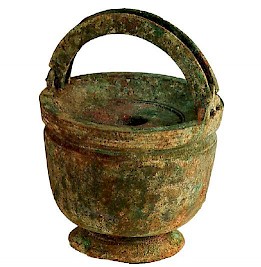Ancient ink, modern exaggeration

In the year AD 79, Mount Vesuvius erupted, destroying Pompeii and several other towns. One of those other settlements was Herculaneum, where, among others, a large villa was destroyed. Archaeologists call it the “Villa of the papyri”, because many scrolls were discovered there. Reading the burned rolls of text, however, turned out to be quite difficult, because unrolling those charred scrolls often resulted in the destruction of the texts we’d like to read. Recently, however, some progress was achieved using X-ray light.
That was not the only advance. Last Monday, British newspaper The Guardian reported that researchers
have established that the scribes who copied the ancient texts knew the secret of metallic ink. The find is unexpected because until now, historians had depended on the evidence left by the Roman historian Pliny the Elder … that the Graeco-Roman world used an ink made from smoke collected from wood furnaces.
Now here’s another quote. It’s from the Oxford Handbook of Papyrology. On page 18, it states:
The earliest occurrence of metallic ink is from the third century BCE.
A note refers to an article from 1990, so this information has been around for a quarter of a century at least. It’s therefore a bit odd that researchers studying the Herculaneum papyri claim that “[T]he common belief has been that no metal is present in Greco-Roman inks”.
In fact, research has already moved beyond the recognition that metallic inks have occurred since the third century BC. In Qumran, where the Dead Sea Scrolls were discovered, inkwells were found as well. The traces of their contents have been examined, and guess what? The researchers found copper and aluminum. They suggested that it was possible to use the formula of this Qumran ink to establish the provenance of other manuscripts.
In short, the point has passed already at which the presence of metal in ancient ink might have been something newsworthy. This raises two questions. In the first place: why did the Herculaneum researchers state that there was “a common belief” that no metal was present in ancient inks? They should have known better. And the second question: why do journalists, who are trained to look at the agendas behind press releases, suddenly trust everything written by scholars and scientists?
Further reading
K.L. Rasmussen e.a., “The constituents of the ink from a Qumran inkwell: new prospects for provenancing the ink on the Dead Sea Scrolls” in: Journal of Archaeological Science 39 (2012) 2956-2968.
